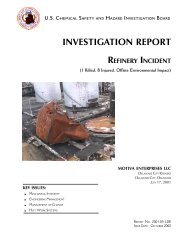CTA Report, Draft 1, ISP Review - US Chemical Safety and Hazard ...
CTA Report, Draft 1, ISP Review - US Chemical Safety and Hazard ...
CTA Report, Draft 1, ISP Review - US Chemical Safety and Hazard ...
You also want an ePaper? Increase the reach of your titles
YUMPU automatically turns print PDFs into web optimized ePapers that Google loves.
• Characterize new <strong>and</strong> existing products with respect to their risks using information about<br />
health, safety, <strong>and</strong> environmental hazards <strong>and</strong> reasonably foreseeable exposures.<br />
• Provide health, safety, <strong>and</strong> environmental information to direct product receivers.<br />
Commensurate with product risk, collaborate on fostering proper use, h<strong>and</strong>ling, recycling,<br />
disposal, <strong>and</strong> transmittal of information to downstream users. When a company identifies<br />
improper practices involving a product, work with the product receiver to improve those<br />
practices. If, in the company’s independent judgment, improvement is not evident, take<br />
further measures—up to <strong>and</strong> including termination of product sale.<br />
Borden <strong>Chemical</strong> was also a member of the Society of the Plastics Industry (SPI) until 1999. This trade<br />
association represents processors, machinery <strong>and</strong> equipment manufacturers, <strong>and</strong> raw material suppliers of<br />
plastics, including phenolic resins. This association works with technical <strong>and</strong> regulatory groups to<br />
develop st<strong>and</strong>ards for product performance <strong>and</strong> safety.<br />
In March 2004, SPI issued a new product stewardship policy to help plastics manufacturers identify <strong>and</strong><br />
manage the health, safety, <strong>and</strong> environmental aspects of their products. SPI has a division dedicated to<br />
phenolic resins that keeps its members updated on safety <strong>and</strong> health issues; however, it has not issued any<br />
publications on phenolic resin hazards.<br />
8.2.3.1 Phenolic Resin Product Stewardship Efforts<br />
In 1997, Borden <strong>Chemical</strong> developed a 2-page fact sheet entitled Phenolic Resin Powders: Frequently<br />
Asked Environmental, Health <strong>and</strong> <strong>Safety</strong> Questions. In answer to: “How finely ground are phenolic resin<br />
powders?”, the sheet explains that 90 percent of phenolic resin particles are below 40 microns in size. In<br />
answer to: “Do phenolic resin dusts pose an explosion hazard?”, the fact sheet states:<br />
67









